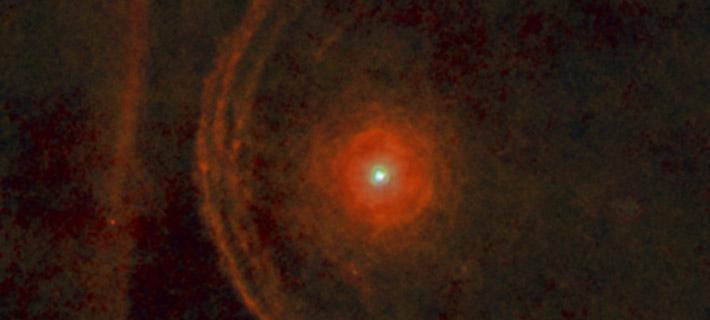| Basic Information | |
| What is this? | The star Betelgeuse. |
| Where is it in the sky? | In the constellation of Orion. |
| How big is it? | The star is 1000 times the diameter of our Sun. |
| How far away is it? | Around 640 light years. |
| What do the colours represent? | The blue material is relatively warm gas and dust. The redder regions show cooler material in the surrounding gas cloud. |
Downloads
See this object in:
However you pronounce its name*, the star Betelgeuse is hard to miss on a clear winter’s night. Representing the top left shoulder of Orion the Hunter it blazes a bright red colour. At over 600 light years away Betelgeuse is not particularly close, but it shines 100,000 times as brightly as our Sun.
Betelgeuse is a “red supergiant” star which is nearing the end of its life. As it has swelled in size over the past few hundred thousand years, currently measuring around 1000 times the size of our Sun, the massive star has been shedding its outer layers. This material is made of gas and dust, which has cooled over time and is seen here in far-infrared light by Herschel.

The ejected outer layers of the star expanded outwards until they hit the surrounding material, creating the arc-like structures seen to the left of the image. These arcs are a bow shock, similar to the wave that travels in front of a ship moving through water, and are caused by Betelgeuse’s motion through the surrounding gas cloud at around 30 km/s (70,000 mph).
Further to the left is what appears to be a straight wall of gas and dust, the origin of which is uncertain. It is very hard to measure distances in images such as this, so the wall could be much futher away or closer to Earth than Betelgeuse – essentially in the foreground or background.
It may be material that was shed by Betelgeuse at an earlier stage – and so has had longer to travel outwards – but it is then hard to explain why it is so straight. It appears to be made of gas and dust of the same composition as the arcs around Betelgeuse, but is slightly cooler, at around -210 Celsius.
Another possibility is that it is just a part of the cloud that Betelgeuse is moving through, and which is being illuminated by the star’s own starlight. If that is the case, and it really is in Betelgeuse’s path, then in around 5000 years the arcs around Betelgeuse will plough into it, and in around 20,000 years the star itself will follow. But don’t worry for the star – the gas clouds are incredibly thin, so such a collision would have no impact Betelgeuse itself.
The immediate surroundings of Betelgeuse look much brighter than the regions further out, implying that around 30,000 years ago the star starting shedding mass at a higher rate. The structure in this “inner envelope” around the star is also assymetric, suggesting that the material has not been flowing out from the star in a uniform way.
As dramatic as this image looks, Betelgeuse has a far more exciting future in store. It weighs in at between 10 and 20 times the mass of our Sun, and such massive stars live fast and die young. Betelgeuse is only around 10 million years old – a tiny fraction of the Sun’s 5 billion years – but is very much in the twilight of its life. At some point in the next million years or so (a blink of an eye in astronomical terms!) the core of the star will run out of fuel, at which point Betelgeuse will die in one of the most violent events in nature – a supernova.
If anyone is around to see that, it will be a magnificent sight to behold in the sky. In the meantime, Betelgeuse is providing astronomers with the opportunity to study an aging, massive star in great detail.
*Some say “Beetle-juice”, others “Bettel-gerz”, but it’s impossible to know how it was originally pronounced. The name Betelgeuse literally means “armpit of the giant” in Arabic, though this is largely due to a historical mis-translation – its original name meant “shoulder of the great one, which is somewhat more dignified!
Detailed Information
- Betelgeuse braces for a collision (ESA Portal)

